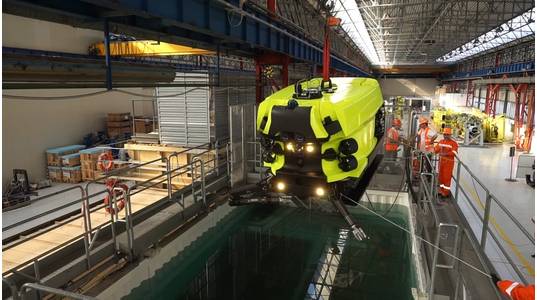
In June, the Hydrone R started a six-month trial in Saipem’s underwater “play park” near Trieste, northeast Italy. Later in the year, or early next year, its FlatFish design is also expected to enter the water, ahead of deep-water trials in 2021. Flatfish is under license from Shell (which bought BG Group, which had in turn been developing the FlatFish concept with Brazilian and German institutions).
Hydrone is in fact part of a family of electric subsea vehicles – from tethered resident work class vehicles through to hybrid autonomous underwater vehicles (AUV) with station keeping features, ranging from high bandwidth real-time control and communications through to low band-width acoustics and autonomous operations - rather than having one vehicle that can do everything. The designs encompass seabed resident systems as well as surface deployed systems, e.g. from a vessel or floating production system.
Hydrone R (for resident) is the first out of the box. It’s described as a hybrid remotely operated underwater vehicle (ROV) with AUV capabilities, e.g. it will have manipulators, for intervention work, and can work on a tether (up to a radius of 300 meters), but also travel distances between subsea fields, untethered, like an AUV, and both either from a seabed garage or a surface deployed system on a mission basis but also able to recharge subsea, Stefano Meggio, Subsea Robotics Technical Manager at Saipem told the energy: connected (aka Subsea Valley) conference in Oslo earlier this year. Rated to 3,000 meters, it could operate for 8-10 hours without a tether, and out to 10 kilometers, when it’s returning to the same base, or 20 kilometers, if it’s transiting to another base.
Saipem is also developing a range of HyTool skids, suitable for all its vehicles, so they can swap them subsea. It’s also developing HyBases; docking stations that would be deployed to provide a communication interface via a subsea production system or to onshore with a direct link or via a surface vessel, and access to those interchangeable payloads where needed. Furthermore, a HyLars, a flying garage deploy from surface host (possibly unmanned), would provide a garage suspended subsea or deployed at seabed for recharging or recovery. Then, HyBuoy, using buoy, with renewable power generation, where subsea infrastructure is unavailable, could provide power and communications to a Hybase on the seabed. There’s also the HyVessel concept, an autonomous surface vessel which could make the subsea system aware of situation and provide supervision capability to an onshore control center.
Meggio says that the commercial solutions for recharging and underwater communications – “acoustic, optical, or whatever the market will bring” – are in now the market. “It’s just a matter of integrating them.” Then, it’s just a case of integrating them.



